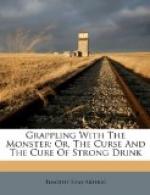It paralyzes the minute blood-vessels, and allows them to become dilated with the flowing blood.
“If you attend a large dinner party, you will observe, after the first few courses, when the wine is beginning to circulate, a progressive change in some of those about you who have taken wine. The face begins to get flushed, the eye brightens, and the murmur of conversation becomes loud. What is the reason of that flushing of the countenance? It is the same as the flush from blushing, or from the reaction of cold, or from the nitrite of amyl. It is the dilatation of vessels following upon the reduction of nervous control, which reduction has been induced by the alcohol. In a word, the first stage, the stage of vascular excitement from alcohol, has been established.”
HEART DISTURBANCE.
“The action of the alcohol extending so far does not stop there. With the disturbance of power in the extreme vessels, more disturbance is set up in other organs, and the first organ that shares in it is the heart. With each beat of the heart a certain degree of resistance is offered by the vessels when their nervous supply is perfect, and the stroke of the heart is moderated in respect both to tension and to time. But when the vessels are rendered relaxed, the resistance is removed, the heart begins to run quicker, like a watch from which the pallets have been removed, and the heart-stroke, losing nothing in force, is greatly increased in frequency, with a weakened recoil stroke. It is easy to account, in this manner, for the quickened heart and pulse which accompany the first stage of deranged action from alcohol, and you will be interested to know to what extent this increase of vascular action proceeds. The information on this subject is exceedingly curious and important.”
* * * * *
“The stage of primary excitement of the circulation thus induced lasts for a considerable time, but at length the heart flags from its overaction, and requires the stimulus of more spirit to carry it on in its work. Let us take what we may call a moderate amount of alcohol, say two ounces by volume, in form of wine, or beer, or spirits. What is called strong sherry or port may contain as much as twenty-five per cent. by volume. Brandy over fifty; gin, thirty-eight; rum, forty-eight; whisky, forty-three; vin ordeinaire, eight; strong ale, fourteen; champagne, ten to eleven; it matters not which, if the quantity of alcohol be regulated by the amount present in the liquor imbibed. When we reach the two ounces, a distinct physiological effect follows, leading on to that first stage of excitement with which we are now conversant. The reception of the spirit arrested at this point, there need be no important mischief done to the organism; but if the quantity imbibed be increased, further changes quickly occur. We have seen that all the organs of the body are built upon the vascular structures, and therefore it follows that a prolonged paralysis of the minute circulation must of necessity lead to disturbance in other organs than the heart.”




